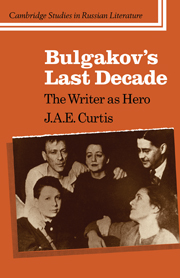1 - The tempering of the steel
Published online by Cambridge University Press: 05 November 2011
Summary
Drafts can never be destroyed. In poetry, in the plastic arts, and in art as a whole there is no such thing as a ready-made work.
Osip Mandel'shtamWe shall shortly be celebrating the twentieth anniversary of the arrival of a new master on the literary scene, an author whose reputation is still gathering momentum in the West, while today in the USSR he is frequently spoken of as the greatest prose writer of the Soviet era. The publication of the first complete text of Master i Margarita (The Master and Margarita) in 1973 after an earlier, partial publication in 1966–7 marked not so much the rehabilitation of Mikhail Bulgakov as his resurrection. For his fate was not that of Mandel'shtam or Babel'; he was never accused of any crime, and he survived the Terror of the late 1930s to die in his bed of a hereditary disease in March 1940. This is not to say that his path had been an easy one, and the integrity of his writings has indeed quelled any doubts in the minds of those who initially wondered how he came to escape the fate of so many of his colleagues. He can now be ranked alongside Akhmatova and Pasternak as one of those writers who earned the dubious privilege of Stalin's respect, and whose tactical concessions to the ruler's vanity weigh as nothing when measured against their ardent championing of freedom and of art.
- Type
- Chapter
- Information
- Bulgakov's Last DecadeThe Writer as Hero, pp. 1 - 28Publisher: Cambridge University PressPrint publication year: 1987



